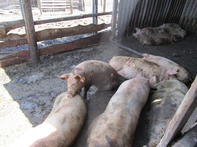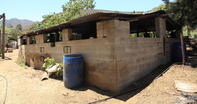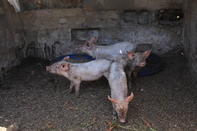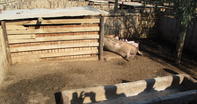


Cost: Modern structures are extremely expensive, so it might be better to start with a couple of pigs to ensure you are in it for the long run before making such a huge investment.
When making the investment, infrastructure and production costs should all be considered to ensure the business will be economically viable. It would be worthwhile to consult an expert to help with the business planning. Building material: Pigs can be destructive, so choose building material, such as steel and cement that would last long.

Escape-proof: Walls or fences should be sunk into the ground and strengthened at the base to prevent pigs from escaping, as they are very good diggers, and also to keep potential threats, such as rodents, parasites and predators out.
Shelter: The structure should supply adequate shade and shelter from rain and cold winds.
Easy-cleaning: It should be easy to clean the structure and its floors should preferably be hard and gently sloped to the side for easy drainage. An outside pen should be large and the floor absorbent enough to prevent the accumulation of excess water. (This does not mean that the pigs should not be allowed to wallow in clean mud.)

Ventilation: Closed structures should be designed to allow good ventilation of air, which will help to prevent respiratory problems. The less expensive structures make use of natural ventilation, whereas the most sophisticated and expensive structures make use of automated climate control technologies.
Space: Each pig should have enough space to be comfortable. According to the welfare code, grower pigs that are kept indoors, should have access to at least one square meter per 100 kg live mass. Outdoor pigs will require even more space, with at least 15 square meters each recommended for outdoor sows.
Overcrowding will lead to fighting, tail biting and poor growth. With sufficient space, the pigs will choose a toilet area far from their sleeping place, leaving most of the floor area dry and clean.
Safe: There should not be any sharp objects or projecting nails that can hurt the pigs and the floor should not be slippery. The structure should also be designed to prevent unnecessary injuries.
Access: There should be a gate or door to every pen, to allow easy movement of pigs and people in and out of the pens.
By Glenneis Kriel